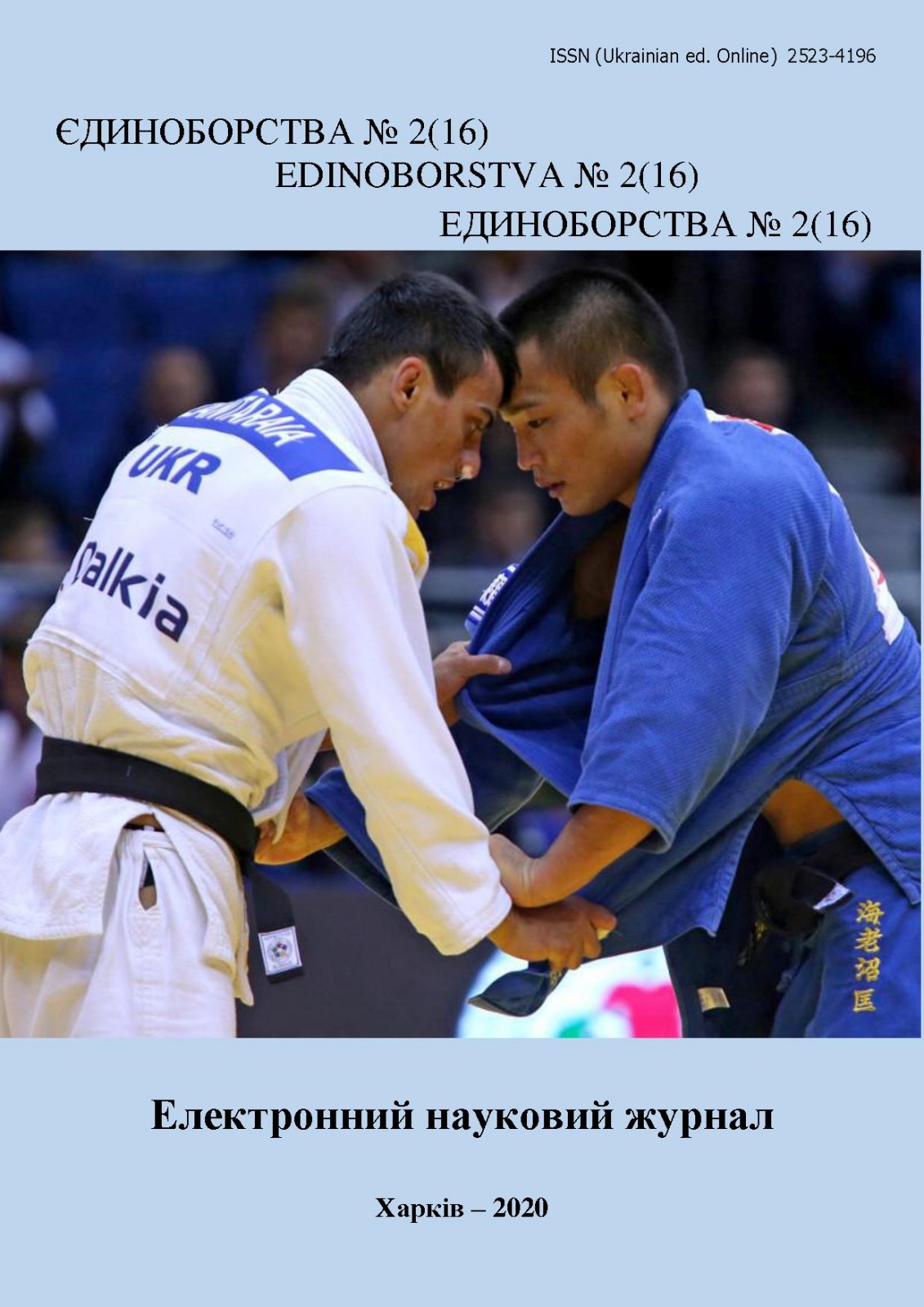Improvement of technical and tactical preparation of judoists 17-18 years
DOI:
https://doi.org/10.15391/ed.2020-2.01Keywords:
judo, sparring, reception, throws, technique, weight category, elements, training, expertsAbstract
Purpose: to identify the impact of training judoka with sparring partners of different qualifications and weight on the level of their technical and tactical preparedness. Material and methods. During pedagogical research the method of expert assessments was used. The experts evaluated the technique of performing the throws of the athletes under study. During the study the following methods were used: theoretical analysis and generalization of literary sources, pedagogical observations, method of expert assessments, methods of mathematical statistics. A pedagogical study was conducted to accomplish the goal and the tasks set. A pedagogical experiment was conducted to test the effectiveness of the proposed special training methodology. Participants of the experiment - members of the sports club in judo «Slobozhanets» (Kharkiv) were 5 groups. The age of subjects - 17-18 years. Results: аll athletes were divided into control and experimental groups and divided into five groups. The first, second and fifth groups consisted of 12 athletes, the third and fourth by 11 judo players. We conducted the selection of sparring partners as an improvement in the training of fighters, which allows us to fulfill the main goal, the essence of which is to optimize and individualize the technical and tactical training through a purposeful selection of different in weight and qualification of the sparring partners. At the end of the experiment, the experts evaluated the accuracy of the following technical indicators: elimination of the opponent's equilibrium; work and position of arms, legs and trunk; Control your opponent during throw and landing. Analyzing the results of the research we observe the following features of technical and tactical preparedness: judoists of the 5th group have relatively higher indicators of the number of attempts to carry out technical and tactical actions, activity, number of evaluated actions, quantitative indicator of efficiency and effectiveness; and smaller measurements of versatility of technical readiness, motor asymmetry, volume of technical actions, and a qualitative indicator of efficiency than fighters of 1-4 groups. The performance of throws improved in judo players of all experimental groups, in athletes of groups 2,3,4 this indicator increased significantly in comparison with the fighters of groups 1 and 5. Conclusions. As a result of the analysis of the research materials, specific features of the technical arsenal of fighters of different styles and development of morpho-functional indicators were revealed, which allowed to develop types (models) with their advantages and disadvantages, strengths and weaknesses of the competitive manner. The effectiveness of the use of throws in competitions under the program «Day of struggle», was experimental 40 % and control 30 %.
References
Алексєєв, А. Ф., Ананченко, К. В., & Бойченко, Н. В. (2014). Теорія та методика викладання дзюдо та самбо: навч. посіб. для студенів 3 курсу (за кредитно-модульною системою). ХДАФК, Xарків.
Ананченко, К. В., & Середа, В. В. (2008). Технічна підготовка юних дзюдоїстів на основі аналізу модельних характеристик. Teorìâ ta Metodika Fìzičnogo Vihovannâ, (8), 47-49.
Ананченко, К. В., & Хацаюк, О. В. (2018). Особливості тренувального процесу та техніко-тактичної підготовленості дзюдоїстів-ветеранів. Единоборства, 4-18.
Ермаков, С. С., Тропин, Ю. Н., & Бойченко, Н. В. (2016). Специальная физическая подготовка квалифицированных борцов. Единоборства, 20-22.
Загура, Ф. І. (2001). Модельні характеристики кваліфікованих борців-дзюдоїстів. Молода спортивна наука України, Вип. 5, Т. 1., 329-331.
Загура, Ф. І. (2003). Модельні характеристики змагальної діяльності дзюдоїстів різних манер ведення сутички. Молода спортивна наука України, Вип. 7, Т. 3, 187-190.
Платонов, В. Н. (2015). Система подготовки спортсменов в олимпийском спорте. Общая теория и практические приложения: учебник [для тренеров] : 2 кн. Олимп. лит., Киев.
Перебейнос В. Б., Ананченко К. В. (2012). Формированые технического арсенала джиудоистов-ветеранов. Слобожанский научно-спортивный вестник, (2), 100-103.
Шулика, Ю. А., Коблев, Я. К., Невзоров, В. М., & Схаляхо, Ю. М. (2006). Дзюдо. Система и борьба. Феникс, Москва.
Zhumakulov, Z. P. (2017). Education Technology of Primary Training Sport Wrestling. Eastern European Scientific Journal, 5, 29-35.













